- Bernard Preston homepage
- Beekeeping
- Spicy Peppadew Mead
Spicy peppadew mead
This spicy peppadew mead is an exotic change from your more usual sweet melomels; for those who are not afraid to experiment with something different. It's not cheap to make, using about R400 (20 dollars) of quality natural honey; you will get 5 litres of pure gold for your efforts.
It's akin to the latest rage; a completely natural wine. It is the best mead I have ever made; or tasted.
Experimenting with mead is really only for beekeepers; or those with coins jingling in their pockets and time on their hands. There's no point in going to all this effort using commercial honey and ending up with a second-rate product.
Fermenting foods is one of the time-honoured ways of preserving; the peppadew season lasts for only about two months. Enjoying the benefits of nutrients like capsaicin all year round, coupled with a natural probiotic for the gut makes it eminently worthwhile.
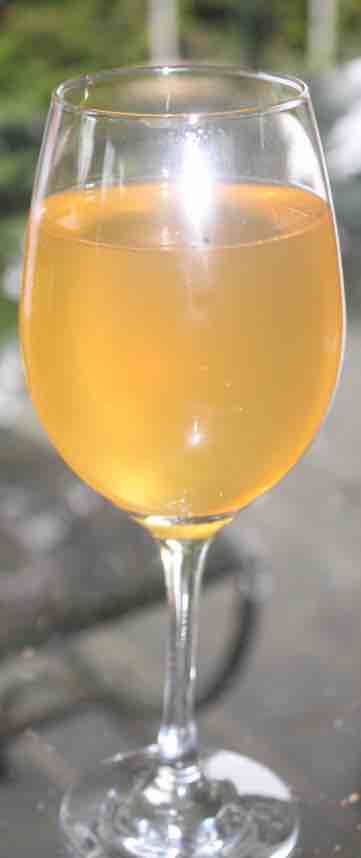
It's important to make a few notes; the date you started the mead, the pH and SG readings. What you did to correct the acidity at each stage too is vital.
Since this spicy peppadew mead has fruit in it we should really call it a melomel.
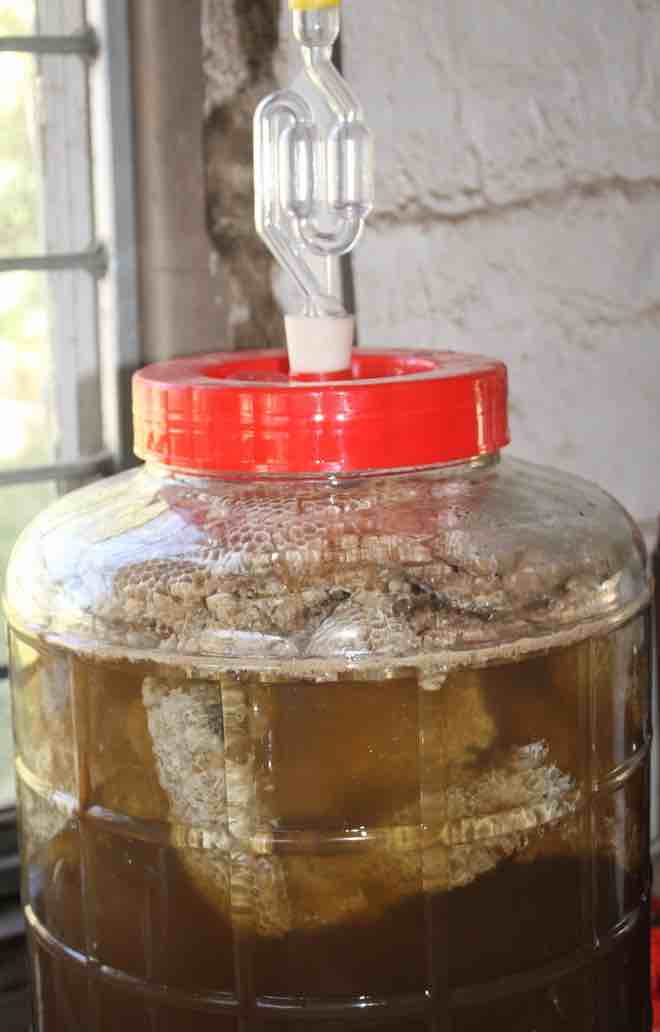
The sugars for our spicy peppadew mead today come from three sources; burr comb which can be seen floating in the carboy above, that gleaned from the cappings and some liquid natural honey straight from the bottling tank.
You can source any combination of these three that you like. Use of the cappings and comb will mean plenty of nutrients for the yeast. It is sometimes described as an all-hive mead; no artificial chemicals need be added.
Ingredients
- Carboy or demijohn
- Peppadews
- Unheated honey
- Juice and pulp of an orange
- Orange zest
- Black tea
- Boiled rainwater
- White wine yeast
- Small piece of honeycomb with fresh pollen
5 litres
- 5 L demijohn
- 5 peppadews
- 2kg
- 1 orange
- 10g zest
- 1 tsp tea
- Rainwater
- 0.4 tsp yeast
- Honeycomb
8 litres
- 8 L carboy
- 8 peppadews
- 2.6 kg honey
- 1.5 oranges
- 13g zest
- 1.3 tsp tea
- Rainwater
- 0.5 tsp
- Honeycomb
23 litres
- 23L carboy
- 21
- 8kg[1]
- 2
- 40 g zest
- 4 tsp tea
- Rainwater
- 1.5 tsp yeast
- Honeycomb
Go for it
- Sterilize the equipment.
- Remove all peppadew stems and seeds but not the placentas.
- Boil the tea and zest; allow to draw for 20 minutes.
- Pour the honey first and then the hot tea into the carboy.
- Add the peppadews, comb and orange pulp; marbles or river pebbles.
- Add rainwater until half full.
- Measure the pH, temperature and specific gravity.
- Shake the carboy vigorously for ten minutes to aerate the mixture.
- Measure out 1/2 tsp of yeast into half a cup of warm water; after 20 mins add to the must.
- Top up with more water, leaving a small air-gap and fit the bubbler; allow for foaming.
Place the fruit in a muslin bag with marbles to weight it down; so that the peppadews and oranges do not float above the surface.
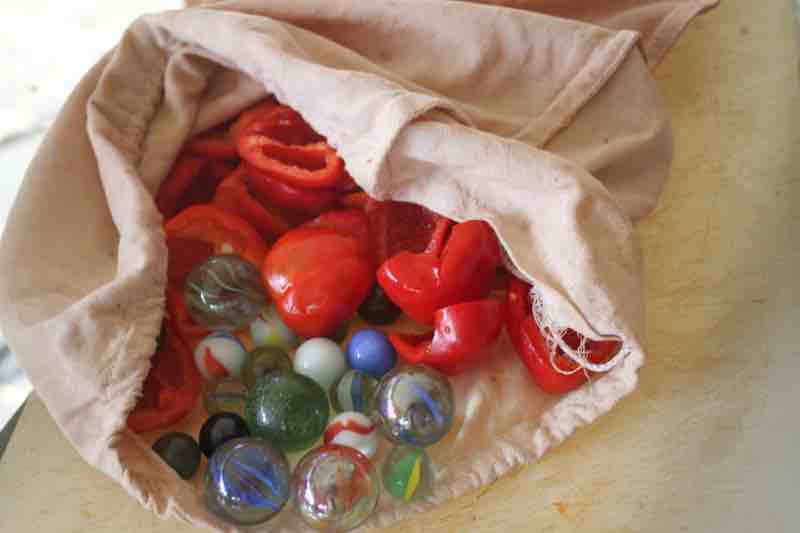
Black tea acts as an astringent. Brew it for twenty-minutes and strain well.
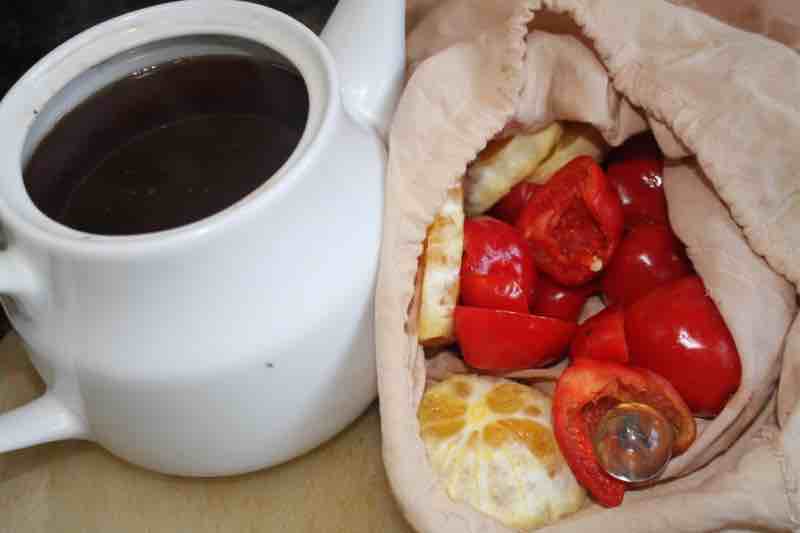
The pH after two weeks was between 4.5 and 5.0; added the juice of one freshly-squeezed lemon. Fermentation was slow; interesting to see if it speeds up.
Stage 2
- Leave the brew to ferment gently for about two months. If necessary keep the carboy warm.
- Test the pH and SG; add bicarb or lemon juice to get the acidity into the 3.5 - 4.5 range.
- Siphon off the liquid into clean, sterilized demijohns.
- Top-up using a mixture of honey and boiled water.
- Fit a bung preferably still with an air-lock. Fermentation can continue for months.
On 3rd August the pH was 2.0; quite acidic. The SG was 1.050. The spicy peppadew mead tasted pretty raw; it was still fermenting.
I removed the bag with the peppadews, oranges and marbles.
Adjusting the acidity
Add 1.25ml of sodium bicarbonate per 0.5 adjustment on 5 litres.
To raise the pH from 2.0 to 3.5 one would need 3 x 1.25ml = 3.75; about half a teaspoon.
For 15 litres of spicy peppadew mead I added 3 x 3.75 = 11.25 ml of bicarb; about 2 tsp. You can always use more later at a subsequent racking.
Add the bicarb very slowly; it will foam.
On the 15th August I racked the spicy peppadew mead into three 5-litre demijohns, all fitted with air traps. The pH was 4.0; perfect. SG was 1.040; it was still bubbling gently. Gosh, this tasted unbelievably good.
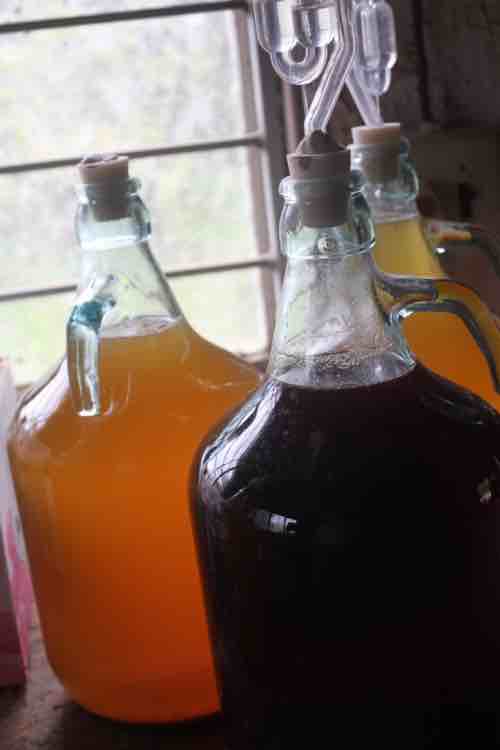
Stage 3
- 3 months later, again test the pH and SG.
- If necessary again add bicarb or lemon juice to adjust the pH.
- Siphon into three clean, sterilized demijohns.
- Top up and fit the bung.
On 13th November I racked the spicy peppadew mead for a second time. Fermentation continued very slowly; just a few bubbles. The pH was 3 and the SG 1.03.
Although the mead had not cleared completely since it was still fermenting, one demijohn was bottled for immediate consumption. It was spectacularly good.
The other two demijohns were set aside to mature and clear; the mead is best when more than a year old.
The lees
The lees are the sediment that forms in your mead; they are predominantly dead and dying yeast cells, killed by the high alcohol concentration. There's a lesson to be learned there!
The "gross lees" settle out quite quickly and will remain at the bottom of the Stage 3 racking. Don't toss them; add them to what I call a "sludge demijohn," mixed with those from other fermentations. They will end up making a fascinating blend that may be even more interesting than your pure spicy peppadew mead.
The "fine lees" will take much longer to settle out; they too may enhance the complexity of your spicy peppadew mead. Together they contribute to what is known generally as the microbiome; the friendly bugs in the gut.
Stage 4
After 6 months siphon into clear bottles of choice.
Cappings
Honey required
- 5L mead, 2kg honey
- 8L mead, 2.6kg honey
- 23L mead, 8kg honey
Cappings. (Mass x 100/38)
- 5.3 kg cappings
- 6.8 kg
- 21 kg
The cappings contain about 38% honey but that is dependent on how long they are left to drip; and whether a hot knife, roller or fork was used.
These gleanings can be used to make your spicy peppadew mead. So to get 2kg of honey you would need about 5.3 kilograms of cappings.
If using a 23L carboy you would need 21kg of cappings; or some liquid honey. The comb fragments would most likely contain plenty of pollen; nutrients for the yeast.
Place the cappings in a large bucket with rainwater at about 40oC and stir until the honey has dissolved; allow to sit for a few hours as the liquid penetrates the cells and then agitate vigorously.
Filter off the wax and pour the liquid into the carboy together with the tea and spicy peppadews.
I now add one small piece of whole fresh comb; prick the cells so the yeast can get to the honey.
Too much wax means you will not be able to add enough rainwater.
There are concerns about the fruit floating at the surface above the liquid. This can be countered by using a porous bag with marbles to weigh down the spicy peppadews. The wax-cappings add yet more nutrients for the yeast.
Next year I will be experimenting with smooth river pebbles for weights; properly sterilised of course.
In short there are many different ways to make your spicy peppadew mead.
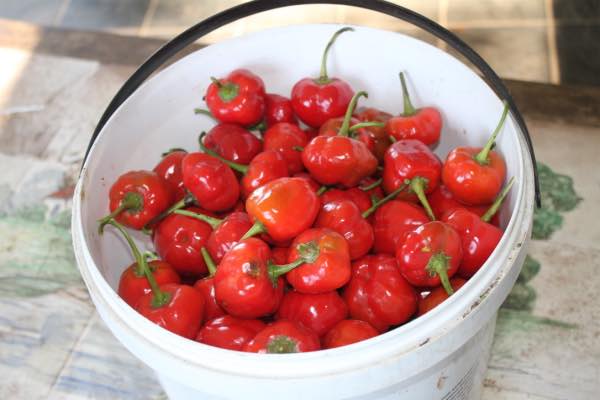
Spicy peppadew mead
This spicy peppadew mead is for those who love brewing and wish to provide the known benefits of the chili family to some of the nether parts of the body.
It is sometimes called a spicy peppadew capsicumel.
Sweetness
8kg of honey made for a lovely but rather too-sweet spicy peppadew mead for my liking.
When I make the next brew in the summer of 2023 I will use 7kg for a semi-dry tipple. The fun is in experimenting to get the taste to your own liking.
In 23 litres use 8kg of honey for a sweet mead.
6.9kg for a semi-dry mead.
That is roughly 1tsp of honey less per glass of 125ml; about 6g.
The standard drink
Following the general guidelines of no more than two or three standard drinks makes a lot of sense; and an alcohol-free day at least once a week.
Yet for those with a generally poor lifestyle even one glass of this spicy peppadew mead per day could be detrimental to health.
So few people drink natural unpasteurised wines and beers that there is no research confirming whether it is detrimental or there is benefit. We take our guidelines from the Blue Zones where longevity is the keyword; their daily tipples together with an overwhelmingly good lifestyle appear to do no harm whatsoever.
A "standard" drink is defined as follow.
- 12 oz of beer, cooler or cider (5% alcohol); 12 oz x 30 = 360 ml.
- 5 oz
of wine (12% alcohol); 150 ml.
- 1.5 oz of spirits such as whiskey, vodka or
gin (40% alcohol); 45 ml.
Capsaicin
Capsaicin is one of the important phytonutrient founds in spicy peppers. It is a powerful painkiller, limiting substance P and has benefits for the prostate gland where it slows the spread of malignant tumours[2].
It is found most richly in the white membrane that holds the seeds; the so-called placenta.
One should eat chilies daily; or drink them in a spicy peppadew mead.
Peppadew mead vinegar
Much research has been done with apple cider vinegar for preservation of the fruit. It utilises a double fermentation; first an alcoholic process by yeast cells followed by acetobacter action.
The acetobacter transforms the alcohol into vinegar; this is an aerobic process requiring oxygen. The carboy is left to stand open to the air.
We utilise this process to make peppadew mead vinegar; first the action of yeast cells followed by the bacteria in the same carboy. The process takes about six months to completion. Recent studies suggest this improves the nutrient content, increasing its status even higher as a functional food.
"Fermented apple juice could be successfully used as a functional food; it is particularly suitable for consumers who are seeking after non-dairy probiotic beverages."
- Roberts et al.
When browsing use right click and "Open Link in New Tab" or you may get a bad gateway signal.
Newsletter
Our newsletter is entitled "create a cyan zone" at your home, preserving both yourself and Mother Earth for future generations; and the family too, of course. We promise not to spam you with daily emails promoting various products. You may get an occasional nudge to buy one of my books.
Here are the back issues.
- Lifestyle and ideal body weight
- What are ultra-processed foods?
- Investing in long-term health
- Diseases from plastic exposure
- Intensive lifestyle management for obesity has limited value
- A world largely devoid of Parkinson's Disease
- The impact of friendly bacteria in the tum on the prevention of cancer
- There's a hole in the bucket
- Everyone is talking about weight loss drugs
- Pull the sweet tooth
- If you suffer from heartburn plant a susu
- Refined maize meal and stunting
- Should agriculture and industry get priority for water and electricity?
- Nature is calling
- Mill your own flour
- Bake your own sourdough bread
- Microplastics from our water
- Alternative types of water storage
- Wear your clothes out
- Comfort foods
- Create a bee-friendly environment
- Go to bed slightly hungry
- Keep bees
- Blue zone folk are religious
- Reduce plastic waste
- Family is important
- What can go in compost?
- Grow broad beans for longevity
- Harvest and store sunshine
- Blue zone exercise
- Harvest and store your rainwater
- Create a cyan zone at your home
Did you find this page interesting? How about forwarding it to a friendly book or food junkie? Better still, a social media tick would help.
- Bernard Preston homepage
- Beekeeping
- Spicy Peppadew Mead
Address:
56 Groenekloof Rd,
Hilton, KZN
South Africa
Website:
https://www.bernard-preston.com